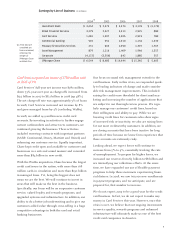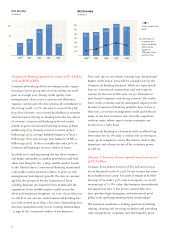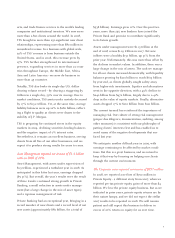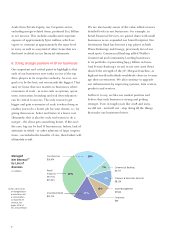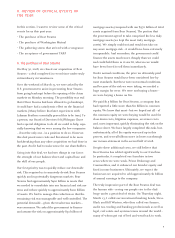JP Morgan Chase 2008 Annual Report Download - page 17
Download and view the complete annual report
Please find page 17 of the 2008 JP Morgan Chase annual report below. You can navigate through the pages in the report by either clicking on the pages listed below, or by using the keyword search tool below to find specific information within the annual report.15
commercial mortgage-backed securities), either directly or
indirectly bought consumer and commercial loans. Asset
securitizations simply were a conduit by which invest-
ment and commercial banks passed the loans onto the
ultimate buyers.
In the two weeks after the Lehman bankruptcy, money
market and bond funds withdrew approximately $700
billion from the credit markets. They did this because
investors (i.e., individuals and institutions) withdrew
money from these funds. At the same time, bank lend-
ing actually went up as corporations needed to increas-
ingly rely on their banks for lending. With this as a
backdrop, let’s revisit the main causes of this crisis in
more detail.
A. The burst of a major housing bubble
U.S. home prices have been appreciating for almost
10 years – essentially doubling over that time. While
some appreciation is normal, the large appreciation,
in this case, and the ultimate damage it caused were
compounded by the factors discussed below.
New and poorly underwritten mortgage products
(i.e., option ARMs, subprime mortgages) helped fuel
asset appreciation, excessive speculation and far higher
credit losses
As the housing bubble grew, increasingly aggressive
underwriting standards helped drive housing price
appreciation and market speculation to unprecedented
levels. Poor underwriting standards (including little or
no verification of income and loan-to-value ratios as
high as 100%) and poorly designed new products (like
option ARMs) contributed directly to the bubble and
its disastrous aftermath.
Mortgage securitization had two major flaws
In many securitizations, no one along the chain, from
originator to distributor, had ultimate responsibility for
the results of the underwriting. In addition, the poorly
constructed tranches of securitizations that comprised
these transactions effectively converted a large portion
of poorly underwritten loans into Triple A-rated securi-
ties. Clearly, the rating agencies also played a key role
in this flawed process. These securitizations ended up
in many forms; the one most discussed is CDOs.
Essentially, these just added a lot more fuel to the fire.
While most people are honorable, excess speculation and
dishonesty were far greater than ever seen before, on the
part of both brokers and consumers
The combination of no-money-down mortgages, specu-
lation on home prices, and some dishonest brokers
and consumers who out-and-out lied will cause damage
for years to come. This, in no way, absolves the poor
underwriting judgments made by us and other institu-
tions, and it certainly doesn’t absolve anyone who
mis-sold loans to consumers.
B. Excessive leverage pervaded the system
Over many years, consumers were adding to their
leverage (mostly as a function of the housing bubble),
some commercial banks increased theirs, most of the
U.S. investment banks dramatically increased theirs
and many foreign banks had the most leverage of all.
In addition, increasing leverage appeared in:
• Hedge funds, many using high leverage, grew dra-
matically over time. Some of that leverage was the
result of global banks and investment banks lending
them too much money.
• Private equity firms were increasingly leveraging up
their buyouts. Again, some banks and the capital
markets lent them too much money.
• Some banks (and other entities) added to their lever-
age by using off-balance sheet arbitrage vehicles, like
SIVs and leveraged puts.
• Nonbank entities, including mortgage banks, CDO
managers, consumer and commercial finance compa-
nies, and even some bond funds, all increased their
leverage over time.
• Even pension plans and universities added to their
leverage, often in effect, by making large “forward-
commitments.”
Basically, the whole world was at the party, high on
leverage – and enjoying it while it lasted.


